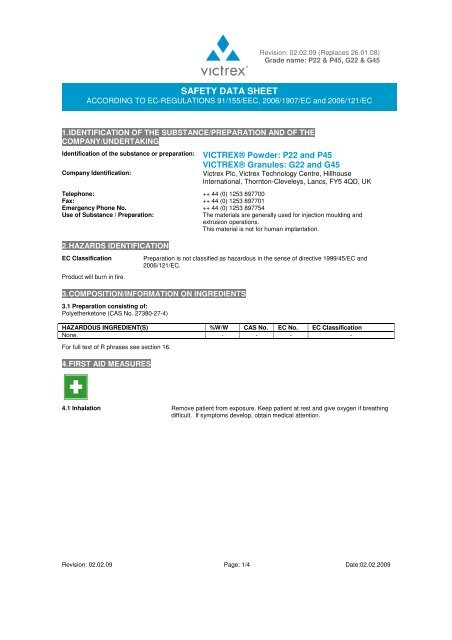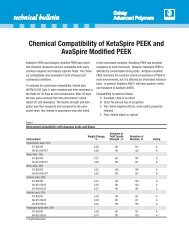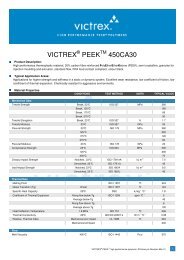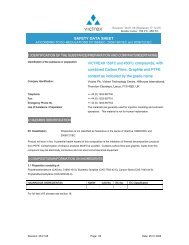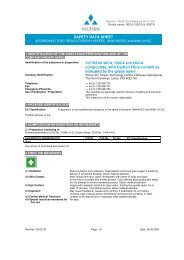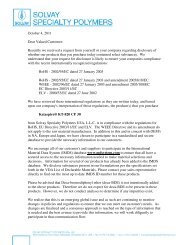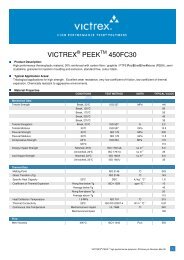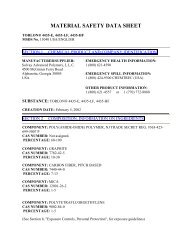Victrex HT G22 & G45 MSDS - Drake Plastics
Victrex HT G22 & G45 MSDS - Drake Plastics
Victrex HT G22 & G45 MSDS - Drake Plastics
- No tags were found...
Create successful ePaper yourself
Turn your PDF publications into a flip-book with our unique Google optimized e-Paper software.
Revision: 02.02.09 (Replaces 26.01.08)Grade name: P22 & P45, <strong>G22</strong> & <strong>G45</strong>SAFETY DATA SHEETACCORDING TO EC-REGULATIONS 91/155/EEC, 2006/1907/EC and 2006/121/EC1. IDENTIFICATION OF THE SUBSTANCE/PREPARATION AND OF THECOMPANY/UNDERTAKINGIdentification of the substance or preparation:Company Identification:VICTREX® Powder: P22 and P45VICTREX® Granules: <strong>G22</strong> and <strong>G45</strong><strong>Victrex</strong> Plc, <strong>Victrex</strong> Technology Centre, HillhouseInternational, Thornton-Cleveleys, Lancs, FY5 4QD, UKTelephone: ++ 44 (0) 1253 897700Fax: ++ 44 (0) 1253 897701Emergency Phone No. ++ 44 (0) 1253 897754Use of Substance / Preparation:The materials are generally used for injection moulding andextrusion operations.This material is not for human implantation.2. HAZARDS IDENTIFICATIONEC ClassificationProduct will burn in fire.Preparation is not classified as hazardous in the sense of directive 1999/45/EC and2006/121/EC.3. COMPOSITION/INFORMATION ON INGREDIENTS3.1 Preparation consisting of:Polyetherketone (CAS No. 27380-27-4)HAZARDOUS INGREDIENT(S) %W/W CAS No. EC No. EC ClassificationNone. - - - -For full text of R phrases see section 16.4. FIRST AID MEASURES4.1 Inhalation Remove patient from exposure. Keep patient at rest and give oxygen if breathingdifficult. If symptoms develop, obtain medical attention.Revision: 02.02.09 Page: 1/4 Date:02.02.2009
VICTREX® Powder: P22 and P45, VICTREX® Granules: <strong>G22</strong> and <strong>G45</strong>4.2 Skin Contact After contact with skin, wash immediately with plenty of soap and water.In the event of contact with molten product: Cool affected area quickly withwater. Do not attempt to remove hardened product. Obtain medical attention.4.3 Eye Contact Irrigate with eyewash solution or clean water, holding the eyelids apart, for atleast 15 minutes. If symptoms persist, obtain medical attention.4.4 Ingestion May cause headache, nausea and vomiting. If swallowed, do not inducevomiting: seek medical advice immediately and show this container or label.4.5 Further Medical Treatment Unlikely to be required but if necessary treat symptomatically.4.6 Special resources necessary for No data.first aid5. FIRE-FIG<strong>HT</strong>ING MEASURES5.1 Extinguishing Media As appropriate for surrounding fire. Extinguish with carbon dioxide, dry chemical,foam or waterspray.5.2 Unsuitable Extinguishing Media None known.5.3 Fire Fighting Protective Protective respirator with independent air supply. Full protection, if necessary.Equipment5.4 Special exposure hazardsarising from the substance orpreparation itself, combustionproduct, resulting gases.In case of fire the following can develop: Oxides of carbon. Dust is ignitable butwill not sustain combustion. A high temperature source of ignition is required.Insensitive to sparks. The minimum spark energy required for ignition of a dustcloud is greater than 5000 mJ. It will not train fire, e.g. along beams etc.5.5 Other Dispose of contaminated extinction water according to official regulations.6. ACCIDENTAL RELEASE MEASURESRefer to Section 13 and for personal protection refer to section 86.1 Personal Precautions Avoid inhalation and contact with eyes or skin. Ensure sufficient supply of air. Avoidbuild up of dust. Remove possible cause of ignition – do not smoke. Takeprecautionary measures against static discharges.6.2 Environmental Exposure Avoid release to the environment. Prevent surface and ground water infiltration, asControlswell as ground penetration.6.3 Methods for cleaning up Collect mechanically and dispose of according to Section 13. Avoid build up of dust.7. HANDLING AND STORAGE7.1 HANDLING See Section: 6.1. General hygiene measures for the handling of chemicals areapplicable. Eating, drinking, smoking, as well as food storage, is prohibited inwork room. Avoid build up of dust. Local Exhaust Ventilation at the workplace oron the processing machines required. Note: Danger of explosive dustMachine Cleaning (purging): Purging with other polymers (e.g Polyethylene) at hightemperatures can be hazardous. They may emit decomposition fumes whichcontain oxides of carbon and irritants. Auto ignition may also occur. Local exhaustventilation is required. The relevant Safety Data Sheet for the purge material to beused should be consulted. Additional information can be obtained from the <strong>Victrex</strong>website www.victrex.com7.2 STORAGE Requirements for storage rooms and containers:Not to be stored in gangways or stair wells. Store products enclosed, in originalpacking.Special storage conditions: See Section: 10.2. Store in dry place.Storage Temperature: Ambient.Storage Life:Stable at ambient temperatures.Specific use:Industrial use only.8. EXPOSURE CONTROLS/PERSONAL PROTECTIONEnsure adequate ventilation. This can be achieved by local exhaust ventilation or general ventilation. If this is insufficientto maintain the concentration under the WEL or TRGS 900 values, suitable breathing protection should be worn. Appliesonly if maximum permissible exposure values are listed here.OCCUPATIONAL EXPOSURE LIMITSSUBSTANCE. CAS No. LTEL (8 hrTWA ppm)Dust. (general dust limit value) -WEL: Workplace Exposure Limit (UK HSE EH40)LTEL (8 hrTWAmg/m³)STEL (ppm)STEL(mg/m³)Note:10 Inhalable Dust.4 Respirable Dust.Revision: 02.02.09 Page: 2/4 Date:02.02.2009
VICTREX® Powder: P22 and P45, VICTREX® Granules: <strong>G22</strong> and <strong>G45</strong>8.1 Respirators If above exposure limits are likely to be exceeded, breathing mask with fine dustfilter (EN 143)8.2 Eye Protection Eye protection with side protection (EN 166)8.3 Gloves Impervious Gloves. Plastic or synthetic rubber gloves.Additional information on hand protection – No tests have been performed.When dealing with heated material: Insulating gloves EN 407 (heat).8.4 Other Protective working garments (e.g. safety shoes EN 344, long sleeved protectiveworking garments).9. PHYSICAL AND CHEMICAL PROPERTIESFormSolid. (Granulate)ColourOff-white. (Powder) Grey/Brown (Granules)OdourOdourless.pH (Value)Not known.Boiling Point (°C)Not known.Melting Point (°C) 372Flash Point (°C)Not known.Auto Ignition Temperature (°C) 595Explosive PropertiesMay form explosible dust clouds in air.Oxidising PropertiesNot applicable.Vapour Pressure (Pascal)Not known.Density (g/ml) ~1.3Solubility (Water)Insoluble.10. STABILITY AND REACTIVITY10.1 Conditions to avoid See Section: 7. Stable when handled and stored correctly. Electrostatic charge.Open flame, ignition sources. Decomposes at temperatures above (°C): 450.10.2 Materials to avoid See Section: 7. Concentrated Sulphuric acid.10.3 Hazardous Decomposition See Section: 5.4Product(s)11. TOXICOLOGICAL INFORMATIONThe following information is based on a consideration of the properties of the main components of this mixture.11.1 Ingestion Predicted to be low toxicity under normal conditions of handling and use.11.2 Inhalation Mechanical irritation of the respiratory tract.11.3 Skin Contact Repeated and/or prolonged skin contact may cause irritation.In the event of contact with molten product: Thermal Burns (molten polymer willadhere to skin and cause severe burns).11.4 Eye Contact No data. Dust may have irritant effect on eyes. Permanent damage is unlikely.11.5 Long Term Exposure Chronic effects are unlikely.12. ECOLOGICAL INFORMATION12.1 Environmental Fate and Distribution Insoluble in water. The product has low mobility in soil.12.2 Persistence and Degradation The product is not biodegradable.12.3 Toxicity Low toxicity to aquatic organisms.12.4 Effect on Effluent Treatment Unlikely to affect biological treatment processes.12.5 Water hazard class: Not classified.13. DISPOSAL CONSIDERATIONS13.1 Regulatory information Do not allow to enter drains, sewers or watercourses. Disposal should be inaccordance with local, state or national legislation.13.2 E.C disposal code no: Allocation of a waste code number, according to the European Waste Catalogue,should be carried out in agreement with the regional waste disposal company. Thewaste codes are recommendations based on the scheduled use of this product. Foralternative uses and applications, other waste codes may be allocated under certaincircumstances.07 02 13- waste plastic07 02 99- waste not otherwise specified.13.3 Recommended: Containers must be decontaminated in accordance with all applicable regulations.Revision: 02.02.09 Page: 3/4 Date:02.02.2009
VICTREX® Powder: P22 and P45, VICTREX® Granules: <strong>G22</strong> and <strong>G45</strong>14. TRANSPORT INFORMATIONInternational Transport RegulationsNot classified as dangerous for transport.UN No.:Not applicable.Road/Rail TransportationNot applicable.(ADR/RID):Class/Packing Group:Not applicable.Classification code:Not applicable.LQ:Not applicable.EmS:Not applicable.15. REGULATORY INFORMATIONClassification according to Dangerous Product Regulations incl. EC Directives 67/548/EEC, 1999/45/EC and2006/121/EC.EC ClassificationNot classified as dangerous for supply/use.Hazard SymbolNot applicable.Risk PhrasesNot applicable.Safety PhrasesNot applicable.Observe restrictionsVOC 1999/13/ECINTERNATIONAL INVENTORIESEINECS (Europe)16. OTHER INFORMATIONEINECS: Included.Manufactured in the UK under a Quality System approved to ISO 9001:2000 by <strong>Victrex</strong> Plc.This Safety Data Sheet was prepared in accordance with Directive 2001/58/EC.The following sections contain revisions or new statements: 1 - 16GLOSSARYWEL: Workplace Exposure Limit (UK HSE EH40) / Bmgv: Biological monitoring guidance value (UK HSE EH40) / EH40 –UK Occupational Exposure Limits.Additional information on the properties, processing and application of VICTREX polymers is available at www.victrex.com.These details refer to the product as it is delivered.The statements made here should describe the product with regard to the necessary safety precautions – they are notmeant to guarantee definite characteristics – but they are based on our present up-to-date knowledge.Revision: 02.02.09 Page: 4/4 Date:02.02.2009


